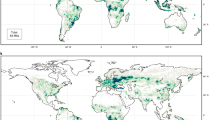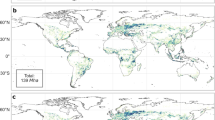Abstract
The potential benefits of biofuels depend on the environmental impacts of biomass production. High-diversity mixtures of grassland species grown on abandoned agricultural lands have been proposed as enhancing climate mitigation potential, but can have low yields. Intensification might increase productivity, but might also cause negative environmental impacts. Here, we show that, compared with more intensive treatments, moderate intensification of high-diversity grasslands had as great or greater biomass yields, soil carbon stores and root mass, and had negligible effects on grassland stability, diversity and nitrate leaching. In particular, compared with untreated plots, the moderate treatment of irrigation and addition of 70 kgN ha−1 yr−1 resulted in 89% more yield, 61% more root carbon, 187% more soil carbon storage and, if biomass were used for bioenergy, twice the greenhouse gas reductions. Irrigation and 140 kgN ha−1 yr−1 had 32% lower greenhouse gas benefits, 10 times greater nitrate leaching and 121% greater loss of plant diversity than the moderate treatment. These results suggest that optimizing multiple environmental benefits requires sustainable intensification practices appropriate for the soils, climate and plant species of a region.
This is a preview of subscription content, access via your institution
Access options
Access Nature and 54 other Nature Portfolio journals
Get Nature+, our best-value online-access subscription
$29.99 / 30 days
cancel any time
Subscribe to this journal
Receive 12 digital issues and online access to articles
$119.00 per year
only $9.92 per issue
Buy this article
- Purchase on Springer Link
- Instant access to full article PDF
Prices may be subject to local taxes which are calculated during checkout




Similar content being viewed by others
Data availability
The data used in this study—experiment e248 of the Cedar Creek Long-Term Ecological Research programme—are available at http://www.cedarcreek.umn.edu/research/data. For data collected before the start of the irrigation and nitrogen fertilization treatments in the 32-species treatment plots, see pre-2002 data for the experiment e120.
References
Tilman, D., Hill, J. & Lehman, C. Carbon-negative biofuels from low-input high-diversity grassland biomass. Science 314, 1598–1600 (2006).
Robertson, G. P. et al. Cellulosic biofuel contributions to a sustainable energy future: choices and outcomes. Science 356, eaal2324 (2017).
Searchinger, T. et al. Use of US croplands for biofuels increases greenhouse gases through emissions from land-use change. Science 319, 1238–1240 (2008).
Fargione, J., Hill, J., Tilman, D., Polasky, S. & Hawthorne, P. Land clearing and the biofuel carbon debt. Science 319, 1235–1238 (2008).
Klopf, R. P., Baer, S. G., Bach, E. M. & Six, J. Restoration and management for plant diversity enhances the rate of belowground ecosystem recovery. Ecol. Appl. 27, 355–362 (2017).
Fargione, J. E. et al. Bioenergy and wildlife: threats and opportunities for grassland conservation. Bioscience 59, 767–777 (2009).
Gelfand, I. et al. Sustainable bioenergy production from marginal lands in the US Midwest. Nature 493, 514–517 (2013).
Sprunger, C. D. & Robertson, P. G. Early accumulation of active fraction soil carbon in newly established cellulosic biofuel systems. Geoderma 318, 42–51 (2018).
Dijkstra, F. A., West, J. B., Hobbie, S. E., Reich, P. B. & Trost, J. Plant diversity, CO2, and N influence inorganic and organic N leaching in grasslands. Ecology 88, 490–500 (2007).
Tilman, D., Reich, P. B. & Knops, J. M. H. Biodiversity and ecosystem stability in a decade-long grassland experiment. Nature 441, 629–632 (2006).
Mitchell, C. E., Tilman, D. & Groth, J. V. Effects of grassland plant species diversity, abundance, and composition on foliar fungal disease. Ecology 83, 1713–1726 (2002).
Kennedy, T. A. et al. Biodiversity as a barrier to ecological invasion. Nature 417, 636–638 (2002).
Campbell, J. E., Lobell, D. B., Genova, R. C. & Field, C. B. The global potential of bioenergy on abandoned agriculture lands. Environ. Sci. Technol. 42, 5791–5794 (2008).
Jungers, J. M. et al. Long-term biomass yield and species composition in native perennial bioenergy cropping systems. Agron. J. 107, 1627–1640 (2015).
Carlsson, G., Mårtensson, L.-M., Prade, T., Svensson, S.-E. & Jensen, E. S. Perennial species mixtures for multifunctional production of biomass on marginal land. GCB Bioenergy 9, 191–201 (2017).
Vermeulen, S. J., Campbell, B. M. & Ingram, J. S. Climate change and food systems. Annu. Rev. Environ. Resour. 37, 195–222 (2012).
Oates, L. G. et al. Nitrous oxide emissions during establishment of eight alternative cellulosic bioenergy cropping systems in the North Central United States. GCB Bioenergy 8, 539–549 (2016).
Wang, M. The Greenhouse Gases, Regulated Emissions, and Energy Use in Transportation (GREET) Model: Version 1.5 Technical Report (Center for Transportation Research, Argonne National Laboratory, 2008).
Tilman, D., Cassman, K. G., Matson, P. A., Naylor, R. & Polasky, S. Agricultural sustainability and intensive production practices. Nature 418, 671–677 (2002).
Garnett, T. et al. Sustainable intensification in agriculture: premises and policies. Science 341, 33–34 (2013).
Di, H. J. & Cameron, K. C. Nitrate leaching in temperate agroecosystems: sources, factors and mitigating strategies. Nutr. Cycl. Agroecosyst. 64, 237–256 (2002).
Spalding, R. F. & Exner, M. E. Occurrence of nitrate in groundwater—a review. J. Environ. Qual. 22, 392–402 (1993).
Bingham, M. A. & Biondini, M. Nitrate leaching as a function of plant community richness and composition, and the scaling of soil nutrients, in a restored temperate grassland. Plant Ecol. 212, 413–422 (2011).
Loiseau, P., Carrere, P., Lafarge, M., Delpy, R. & Dublanchet, J. Effect of soil-N and urine-N on nitrate leaching under pure grass, pure clover and mixed grass/clover swards. Eur. J. Agron. 14, 113–121 (2001).
Leimer, S. et al. Mechanisms behind plant diversity effects on inorganic and organic N leaching from temperate grassland. Biogeochemistry 131, 339–353 (2016).
Simkin, S. M. et al. Conditional vulnerability of plant diversity to atmospheric nitrogen deposition across the United States. Proc. Natl Acad. Sci. USA 113, 4086–4091 (2016).
Clark, C. M. & Tilman, D. Loss of plant species after chronic low-level nitrogen deposition to prairie grasslands. Nature 451, 712–715 (2008).
Isbell, F. et al. Nutrient enrichment, biodiversity loss, and consequent declines in ecosystem productivity. Proc. Natl Acad. Sci. USA 110, 11911–11916 (2013).
Binder, S., Isbell, F., Polasky, S., Catford, J. A. & Tilman, D. Grassland biodiversity can pay. Proc. Natl Acad. Sci. USA 115, 3876–3881 (2018).
Hautier, Y. et al. Eutrophication weakens stabilizing effects of diversity in natural grasslands. Nature 508, 521–525 (2014).
Inouye, R. S. et al. Old-field succession on a Minnesota sand plain. Ecology 68, 12–26 (1987).
Koponen, K., Soimakallio, S., Kline, K. L., Cowie, A. & Brandão, M. Quantifying the climate effects of bioenergy—choice of reference system. Renew. Sustain. Energy Rev. 81, 2271–2280 (2018).
Schlesinger, W. H. Are wood pellets a green fuel? Science 359, 1328–1329 (2018).
Knops, J. M. H. & Bradley, K. L. Soil carbon and nitrogen accumulation and vertical distribution across a 74-year chronosequence. Soil Sci. Soc. Am. J. 73, 2096–2104 (2009).
Gibbs, H. K. & Salmon, J. M. Mapping the world's degraded lands. Appl. Geogr. 57, 12–21 (2015).
Jarchow, M. E. et al. Trade-offs among agronomic, energetic, and environmental performance characteristics of corn and prairie bioenergy cropping systems. GCB Bioenergy 7, 57–71 (2015).
Anderson, E. K. et al. Impacts of management practices on bioenergy feedstock yield and economic feasibility on Conservation Reserve Program grasslands. GCB Bioenergy 8, 1178–1190 (2016).
Jungers, J. M., Sheaffer, C. C., Fargione, J. & Lehman, C. Short-term harvesting of biomass from conservation grasslands maintains plant diversity. GCB Bioenergy 7, 1050–1061 (2015).
Azar, C. et al. The feasibility of low CO2 concentration targets and the role of bio-energy with carbon capture and storage (BECCS). Clim. Change 100, 195–202 (2010).
Righelato, R. & Spracklen, D. V. Carbon mitigation by biofuels or by saving and restoring forests? Science 317, 902 (2007).
Reynolds, L. K., McGlathery, K. J. & Waycott, M. Genetic diversity enhances restoration success by augmenting ecosystem services. PLoS ONE 7, e38397 (2012).
Blumenthal, D. M., Jordan, N. R. & Svenson, E. L. Weed control as a rationale for restoration: the example of tallgrass prairie. Conserv. Ecol. 7, 6 (2003).
Yang, Y. Two sides of the same coin: consequential life cycle assessment based on the attributional framework. J. Clean. Prod. 127, 274–281 (2016).
Rajagopal, D., Hochman, G. & Zilberman, D. Indirect fuel use change (IFUC) and the lifecycle environmental impact of biofuel policies. Energy Policy 39, 228–233 (2011).
Trost, J. J., Kiesling, R. L., Erickson, M. L., Rose, P. J. & Elliott, S. M. Land-Cover Effects on the Fate and Transport of Surface-Applied Antibiotics and 17-Beta-Estradiol on a Sandy Outwash Plain, Anoka County, Minnesota, 2008–09 (US Geological Survey, 2013).
Ruan, L., Bhardwaj, A. K., Hamilton, S. K. & Robertson, G. P. Nitrogen fertilization challenges the climate benefit of cellulosic biofuels. Environ. Res. Lett. 11, 064007 (2016).
Vora, N., Shah, A., Bilec, M. M. & Khanna, V. Food–energy–water nexus: quantifying embodied energy and GHG emissions from irrigation through virtual water transfers in food trade. ACS Sustain. Chem. Eng. 5, 2119–2128 (2017).
Murphy, C. W. & Kendall, A. Life cycle analysis of biochemical cellulosic ethanol under multiple scenarios. GCB Bioenergy 7, 1019–1033 (2015).
Acknowledgements
We thank the Global Climate and Energy Project and NSF Long-Term Ecological Research programme (DEB-0620652 and DEB-1234162) for funding this research, T. Mielke for coordinating data collection, and D. Bahauddin for data management.
Author information
Authors and Affiliations
Contributions
Y.Y. led the data analysis and writing efforts. D.T. established the experiment, contributed to data analysis and writing, and obtained NSF funding. C.L. obtained Global Climate and Energy Project funding and contributed to the writing. J.J.T. planned and performed nitrate leaching analyses and contributed to the writing.
Corresponding author
Ethics declarations
Competing interests
The authors declare no competing interests.
Additional information
Publisher’s note: Springer Nature remains neutral with regard to jurisdictional claims in published maps and institutional affiliations.
Supplementary information
Supplementary Information
Supplementary Tables 1–14, Supplementary References 1–14
Supplementary Dataset
Data for the 4 figures presented in the main text, Detailed data for the life cycle greenhouse gas (GHG) analysis, Estimates of state-level irrigation GHG emissions
Rights and permissions
About this article
Cite this article
Yang, Y., Tilman, D., Lehman, C. et al. Sustainable intensification of high-diversity biomass production for optimal biofuel benefits. Nat Sustain 1, 686–692 (2018). https://doi.org/10.1038/s41893-018-0166-1
Received:
Accepted:
Published:
Issue Date:
DOI: https://doi.org/10.1038/s41893-018-0166-1
This article is cited by
-
Irrigation in the Earth system
Nature Reviews Earth & Environment (2023)
-
The land–energy–water nexus of global bioenergy potentials from abandoned cropland
Nature Sustainability (2021)
-
A strong, biodegradable and recyclable lignocellulosic bioplastic
Nature Sustainability (2021)
-
Environmental tradeoffs in municipal wastewater treatment plant upgrade: a life cycle perspective
Environmental Science and Pollution Research (2021)
-
A unified framework of life cycle assessment
The International Journal of Life Cycle Assessment (2019)



